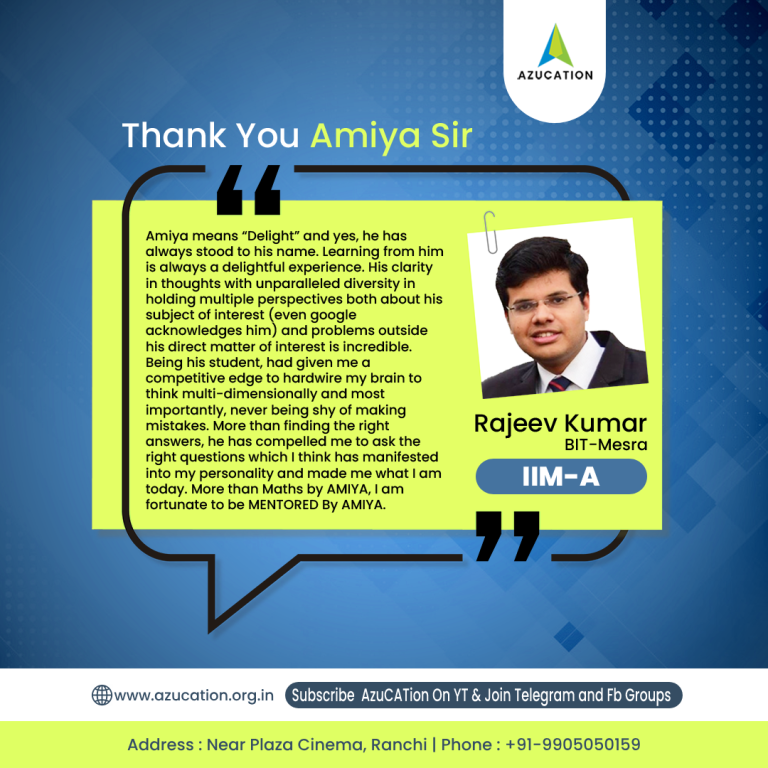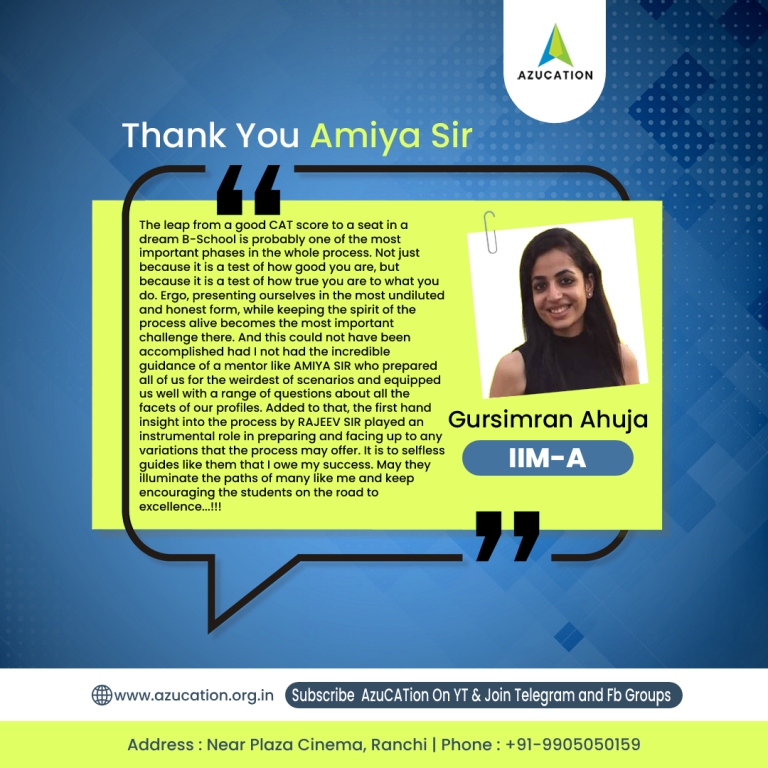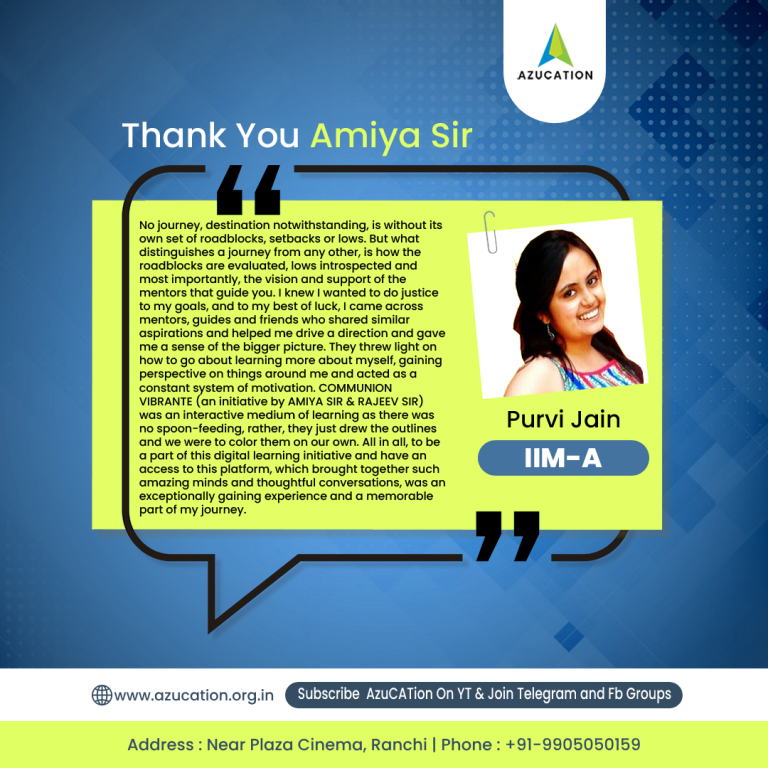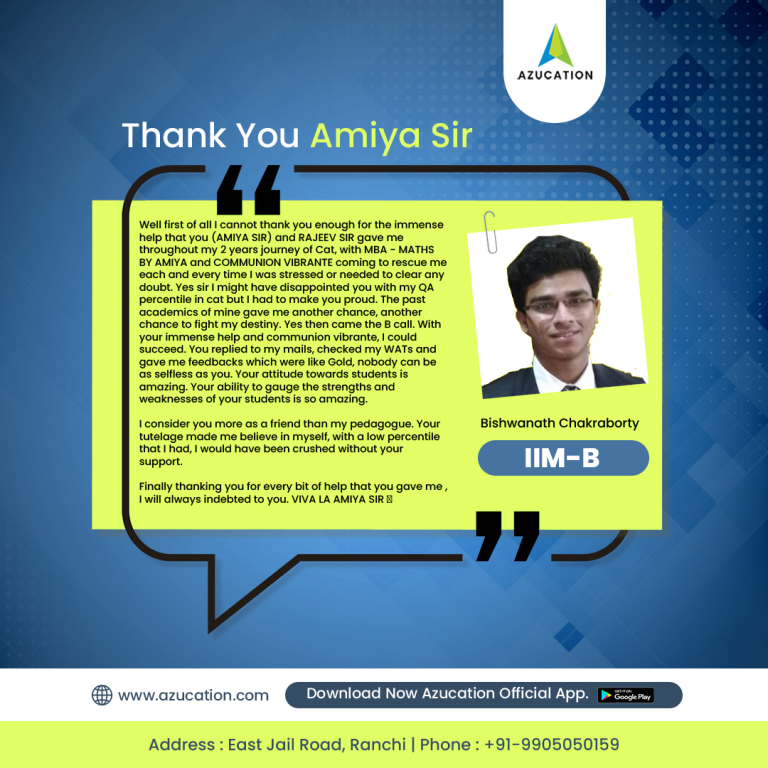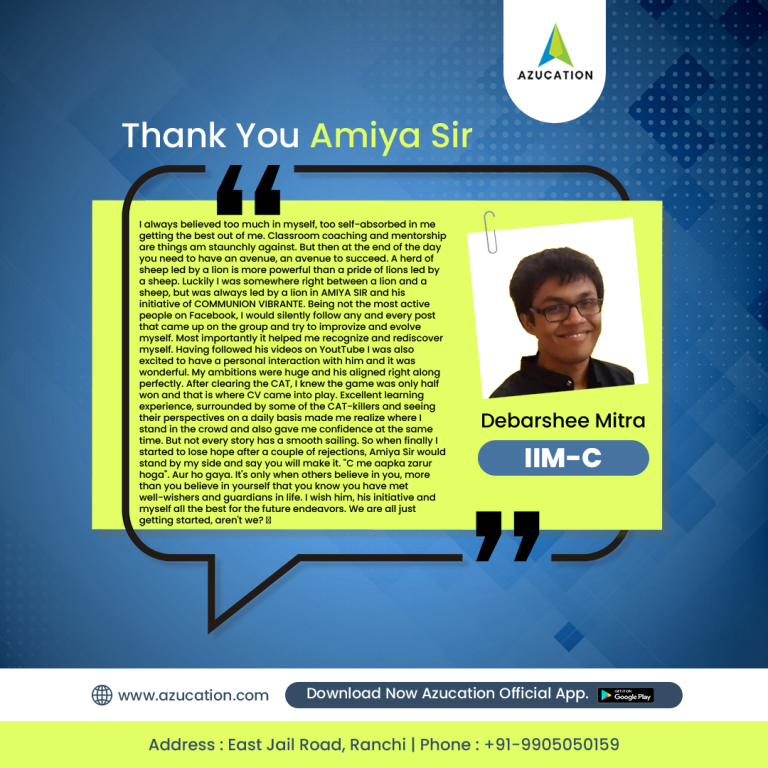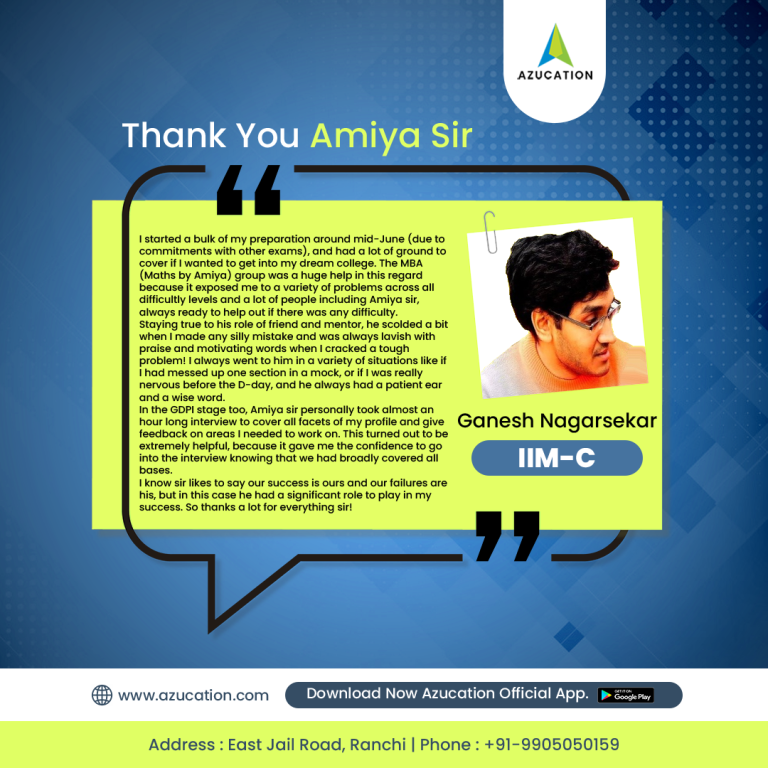CAT 2017 Algebra – Previous Year Questions with Detailed Solutions
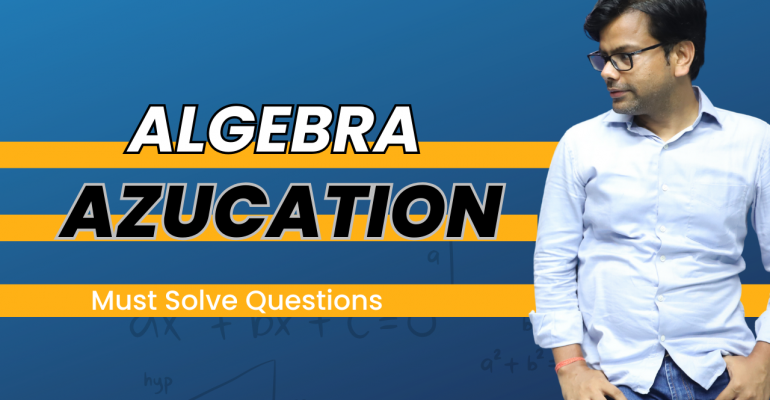
CAT 2017 Algebra – Previous Year Questions with Detailed Solutions
CAT 2017 Algebra – Previous Year Questions with Detailed Solutions
Prepare for CAT Algebra with actual questions from CAT 2017. Below are all Algebra PYQs with clear, concise solutions and explanations. These questions test your grasp of equations, functions, identities, and inequalities — key concepts for CAT Quantitative Aptitude.
CAT Previous Years' Algebra Questions CAT 2017
Click on the toggle to view correct answers. Curated by Azucation.
CAT 2017 Algebra - Q1) If \(a\) and \(b\) are integers of opposite signs such that \((a + 3)^2 : b^2 = 9 : 1\) and \((a - 1)^2 : (b - 1)^2 = 4 : 1\), then the ratio \(a^2 : b^2\) is:
- (a) 9 : 4
- (b) 81 : 4
- (c) 1 : 4
- (d) 25 : 4
Answer: 25 : 4
CAT 2017 Algebra - Q2) The area of the closed region bounded by the equation \(|x| + |y| = 2\) in the two-dimensional plane is:
- (a) \(4\pi\) sq. units
- (b) 4 sq. units
- (c) 8 sq. units
- (d) \(2\pi\) sq. units
Answer: 8 sq. units
CAT 2017 Algebra - Q3) Suppose, \(\log_3 x = \log_{12} y = a\), where \(x, y\) are positive numbers. If \(G\) is the geometric mean of \(x\) and \(y\), then \(\log_6 G\) is equal to:
- (a) \(\sqrt{a}\)
- (b) \(2a\)
- (c) \(a/2\)
- (d) \(a\)
Answer: a
CAT 2017 Algebra - Q4) If \(x + 1 = x^2\) and \(x > 0\), then the value of \(2x^4\) is:
- (a) \(6 + 4\sqrt{5}\)
- (b) \(3 + 3\sqrt{5}\)
- (c) \(5 + 3\sqrt{5}\)
- (d) \(7 + 3\sqrt{5}\)
Answer: 7 + 3\sqrt{5}
🔔 For full video solutions, subscribe to AzuCATion
CAT 2017 Algebra - Q5) The value of \[ \log_{0.008} \sqrt{5} + \log_{\sqrt{3}} 81 - 7 \] is equal to:
- (a) \( \frac{1}{3} \)
- (b) \( \frac{2}{3} \)
- (c) \( \frac{5}{6} \)
- (d) \( \frac{7}{6} \)
Answer: \(\frac{5}{6}\)
CAT 2017 Algebra - Q6) If \[ 9^{2x - 1} - 81^{x - 1} = 1944, \] then \(x\) is:
- (a) 3
- (b) \( \frac{9}{4} \)
- (c) \( \frac{4}{9} \)
- (d) \( \frac{1}{3} \)
Answer: \(\frac{9}{4}\)
CAT 2017 Algebra - Q7) The number of solutions \((x, y, z)\) to the equation \[ x - y - z = 25, \] where \(x, y, z\) are positive integers such that \(x \leq 40\), \(y \leq 12\), and \(z \leq 12\), is:
- (a) 101
- (b) 99
- (c) 87
- (d) 105
Answer: 99
CAT 2017 Algebra - Q8) For how many integers \(n\), will the inequality \[ (n - 5)(n - 10) - 3(n - 2) \leq 0 \] be satisfied?
🔽 Show AnswerAnswer: 11
CAT 2017 Algebra - Q9) If \(f_1(x) = x^2 + 11x + n\) and \(f_2(x) = x\), then the largest positive integer \(n\) for which the equation \[ f_1(x) = f_2(x) \] has two distinct real roots is:
🔽 Show AnswerAnswer: 24
CAT 2017 Algebra - Q10) If \(a, b, c,\) and \(d\) are integers such that \(a + b + c + d = 30\), then the minimum possible value of \[ (a - b)^2 + (a - c)^2 + (a - d)^2 \] is:
🔽 Show AnswerAnswer: 2
CAT 2017 Algebra - Q11) The shortest distance of the point \[ \left(\frac{1}{2}, 1\right) \] from the curve \[ y = |x - 1| + |x + 1| \] is:
- (a) 1
- (b) 0
- (c) \(\sqrt{2}\)
- (d) \(\sqrt{\frac{3}{2}}\)
Answer: 1
CAT 2017 Algebra - Q12) If \[ f(x) = \frac{5x + 2}{3x - 5} \quad \text{and} \quad g(x) = x^2 - 2x - 1, \] then the value of \[ g(f(f(3))) \] is:
- (a) 2
- (b) \(\frac{1}{3}\)
- (c) 6
- (d) \(\frac{2}{3}\)
Answer: 2
CAT 2017 Algebra - Q13) Let \(a_1, a_2, \ldots, a_{3n}\) be an arithmetic progression with \(a_1 = 3\) and \(a_2 = 7\). If \[ a_1 + a_2 + \ldots + a_{3n} = 1830, \] then what is the smallest positive integer \(m\) such that \[ m(a_1 + a_2 + \ldots + a_n) > 1830? \]
- (a) 8
- (b) 9
- (c) 10
- (d) 11
Answer: 9
CAT 2017 Algebra - Q14) If \(a, b, c\) are three positive integers such that \(a : b = 3 : 4\) and \(b : c = 2 : 1\), then which one of the following is a possible value of \(a + b + c\)?
- (a) 201
- (b) 205
- (c) 207
- (d) 210
Answer: 207
CAT 2017 Algebra - Q15) If the product of three consecutive positive integers is 15600, then the sum of the squares of these integers is:
- (a) 1777
- (b) 1785
- (c) 1875
- (d) 1877
Answer: 1877
CAT 2017 Algebra - Q16) If \(x\) is a real number such that \[ \log_3 5 = \log_5 (2 + x), \] then which of the following is true?
- (a) \(0 < x < 3\)
- (b) \(23 < x < 30\)
- (c) \(x > 30\)
- (d) \(3 < x < 23\)
Answer: 3 < x < 23
CAT 2017 Algebra - Q17) Let \(f(x) = x^2\) and \(g(x) = 2^x\) for all real \(x\). Then the value of \[ f[f(g(x)) + g(f(x))] \text{ at } x = 1 \] is:
- (a) 16
- (b) 18
- (c) 36
- (d) 40
Answer: 36
CAT 2017 Algebra - Q18) The minimum possible value of the sum of the squares of the roots of the equation \[ x^2 + (a + 3)x - (a + 5) = 0 \] is:
- (a) 1
- (b) 2
- (c) 3
- (d) 4
Answer: 3
CAT 2017 Algebra - Q19) If \[ 9^{x - \frac{1}{2}} - 2^{2x - 2} = 4^x - 3^{2x - 3}, \] then \(x\) is:
- (a) \( \frac{3}{2} \)
- (b) \( \frac{2}{5} \)
- (c) \( \frac{3}{4} \)
- (d) \( \frac{4}{9} \)
Answer: \(\frac{3}{2}\)
CAT 2017 Algebra - Q20) If \[ \log(2^a \cdot 3^b \cdot 5^c) \] is the arithmetic mean of \[ \log(2^2 \cdot 3^3 \cdot 5),\quad \log(2^6 \cdot 3 \cdot 5^7),\quad \text{and} \quad \log(2 \cdot 3^2 \cdot 5^4), \] then \(a\) equals:
🔽 Show AnswerAnswer: 3
CAT 2017 Algebra - Q21) Let \(a_1, a_2, a_3, a_4, a_5\) be a sequence of five consecutive odd numbers. Consider a new sequence of five consecutive even numbers ending with \(2a_3\). If the sum of the numbers in the new sequence is 450, then \(a_5\) is:
🔽 Show AnswerAnswer: 51
CAT 2017 Algebra - Q22) How many different pairs \((a, b)\) of positive integers are there such that \(a \geq b\) and \[ \frac{1}{a} + \frac{1}{b} = \frac{1}{6}? \]
🔽 Show AnswerAnswer: 5
CAT 2017 Algebra - Q23) If \(f(ab) = f(a)f(b)\) for all positive integers \(a\) and \(b\), then the largest possible value of \(f(1)\) is:
🔽 Show AnswerAnswer: 1
CAT 2017 Algebra - Q24) Let \(f(x) = 2x - 5\) and \(g(x) = 7 - 2x\). Then \(|f(x)+g(x)| = |f(x)| + |g(x)|\) if and only if:
- (a) \(\frac{5}{2} < x < \frac{7}{2}\)
- (b) \(x \leq \frac{5}{2}\) or \(x \geq \frac{7}{2}\)
- (c) \(x < \frac{5}{2}\) or \(x > \frac{7}{2}\)
- (d) \(\frac{5}{2} \leq x \leq \frac{7}{2}\)
Answer: \(\frac{5}{2} \leq x \leq \frac{7}{2}\)
CAT 2017 Algebra - Q25) An infinite geometric progression \(a_1, a_2, \dots\) has the property that \[ a_n = 3(a_{n+1} + a_{n+2} + \ldots) \] for every \(n \geq 1\). If the sum \(a_1 + a_2 + a_3 + \dots = 32\), then \(a_5\) is:
- (a) \(\frac{1}{32}\)
- (b) \(\frac{2}{32}\)
- (c) \(\frac{3}{32}\)
- (d) \(\frac{4}{32}\)
Answer: \(\frac{3}{32}\)
CAT 2017 Algebra - Q26) If \[ a_1 = \frac{1}{2 \times 5},\quad a_2 = \frac{1}{5 \times 8},\quad a_3 = \frac{1}{8 \times 11}, \ldots, \] then \[ a_1 + a_2 + a_3 + \ldots + a_{100} \] is:
- (a) \(\frac{25}{151}\)
- (b) \(\frac{1}{2}\)
- (c) \(\frac{1}{4}\)
- (d) \(\frac{111}{55}\)
Answer: \(\frac{25}{151}\)










